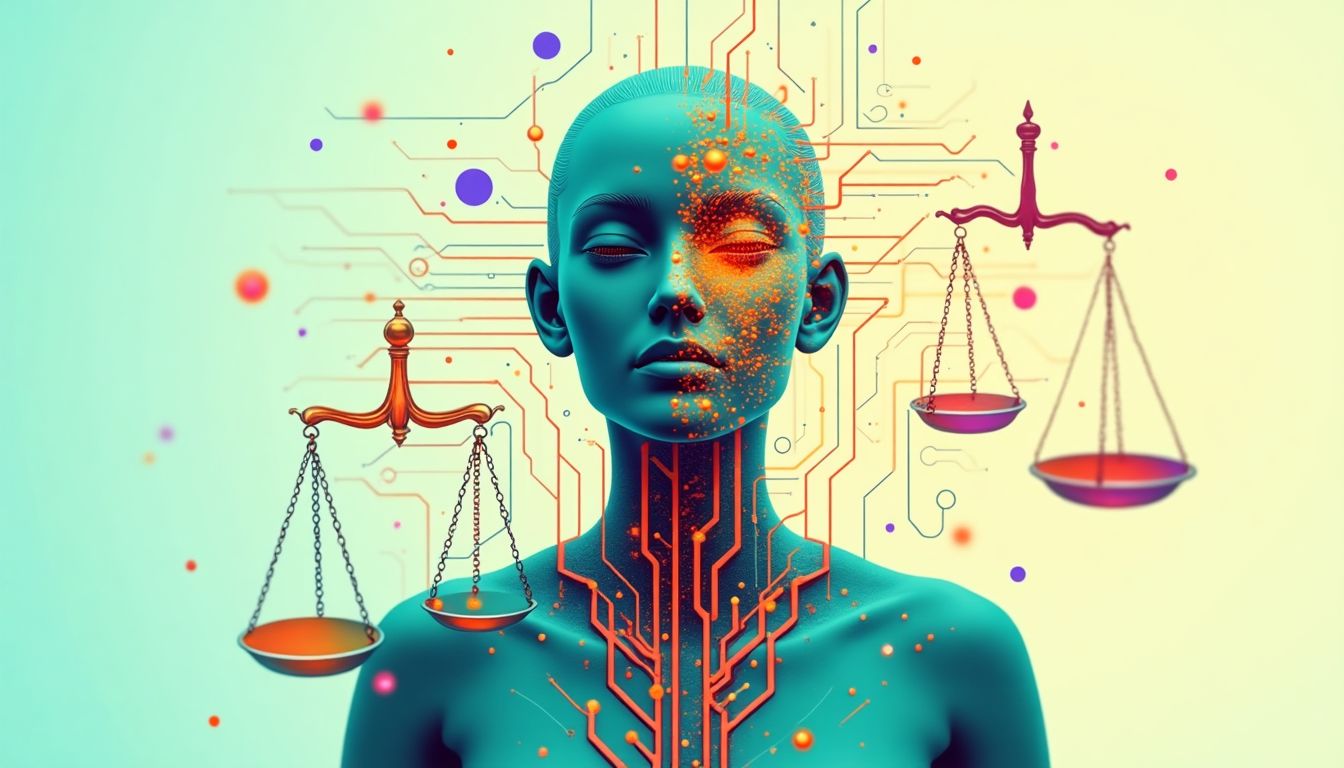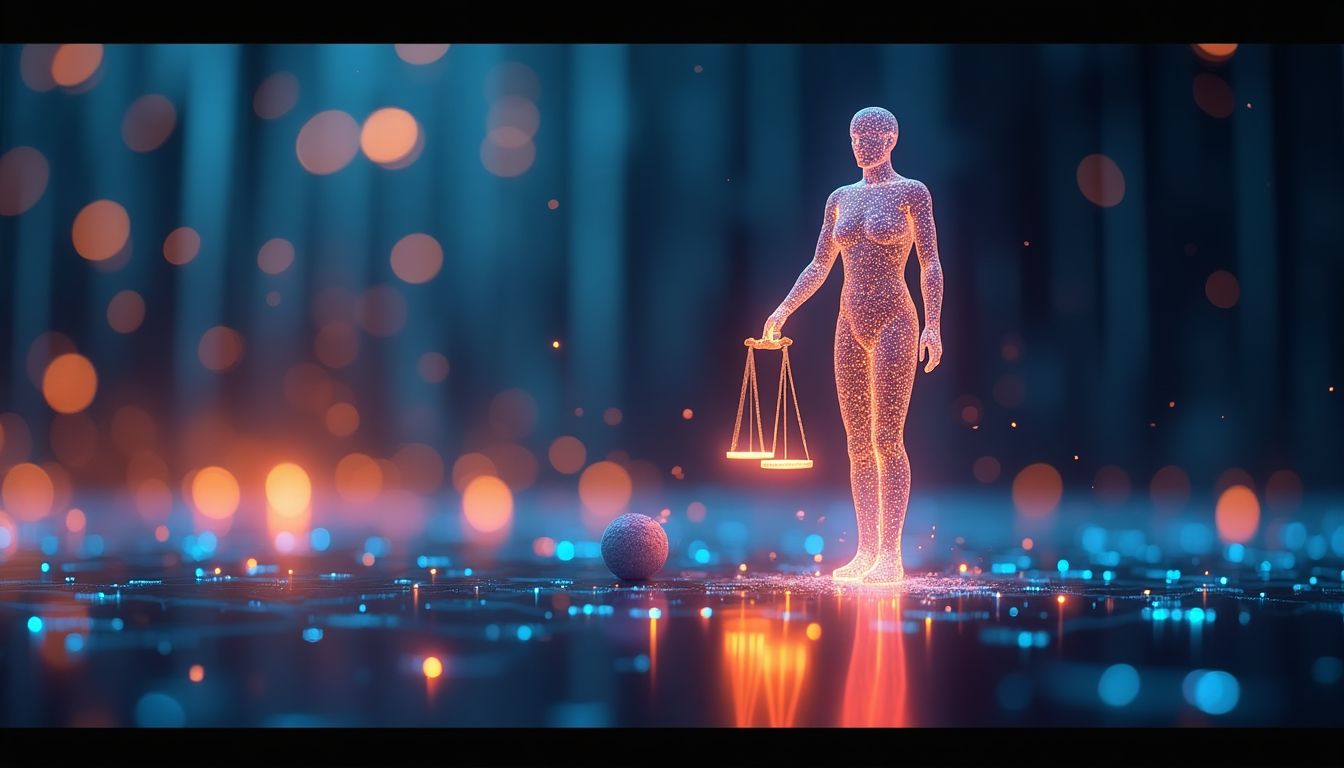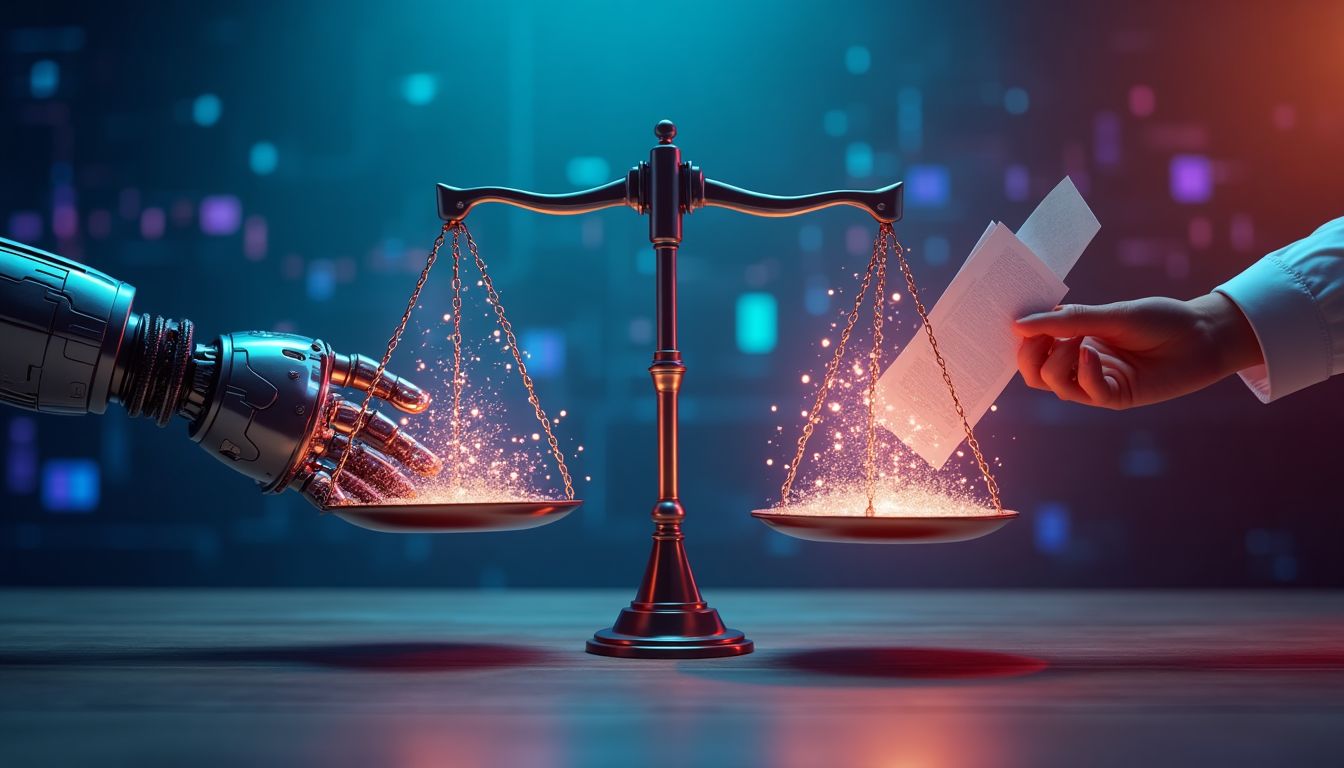Introduction: The Future of Law and Justice
Justice delayed is justice denied. - William E. Gladstone This quote rings terrifyingly true given the age of technology we find ourselves in. In a world where every second counts and information spreads like wildfire, our justice system often seems stuck in molasses. Gladstone’s wise words suggest that the longer we wait for justice, the more we are robbed of it. With the rise of artificial intelligence (AI), we have a unique opportunity to speed up those processes and perhaps even redefine what justice looks like. But it raises one huge question: What happens when machines take the stand in our legal system?
Imagine a courtroom where algorithms analyze evidence faster than any human could, weighing morality and legality in the blink of an eye. We find ourselves at a pivotal moment, where the marriage of AI and justice could either lead to an age of unprecedented equality or kick us down a rabbit hole of bias and ethical dilemmas. Will AI serve as the dutiful servant of justice, or like a pesky cat, create more chaos than order? This inquiry leads us into a deep examination of the profound implications of AI's role within the courtroom, a setting that some might argue is as chaotic as a cat chasing its tail!
In this exploration, we delve into the multifaceted ways artificial intelligence could transform the justice system, from evidence analysis to predicting outcomes. We’ll also face the pressing questions about fairness and integrity that linger like a silent specter. We are not just tapping into the minds of *Isaac Asimov*, *Yuval Noah Harari*, and *Nora Ephron*, but also probing the ethical and functional dilemmas we face today.
1. The Role of AI in Evidence Analysis
Artificial Intelligence is changing how evidence is collected, analyzed, and presented in courts. From document review to forensic analysis, AI can sift through vast datasets to unearth crucial information that human investigators might overlook. Imagine an overworked detective who's searching for a needle in a haystack. AI acts like a super-powered magnet, drawing out those needles with its extraordinary speed and accuracy!
1.1 The Mechanics of AI Evidence Analysis
How does this super-powered magnet work? Well, it involves machine learning algorithms that can identify patterns, categorize documents, and even flag anomalies in data pertinent to a case. These algorithms are designed to mimic human thinking and learning, allowing them to discern subtle nuances in evidence that might otherwise slip under the radar. For example, researchers at the University of California, Berkeley have explored how AI can effectively streamline document reviews in litigation, slicing through countless files within seconds.
1.2 Applications in Forensic Science
AI isn't just confined to paperwork; it’s shaking things up in the lab too! In forensic science, AI can analyze DNA, reconstruct crime scenes, and dig through digital forensics. Imagine you're a forensic expert trying to piece together a puzzle with a missing piece — AI can step in and use advanced algorithms to predict where that piece might fit based on existing data. AI tools like those developed by NEC Corporation are pioneering advancements in facial recognition technology for criminal investigations, showcasing how AI can enhance accuracy in the most critical pieces of evidence.
2. AI in Predicting Case Outcomes
Imagine walking into a courtroom and knowing the odds of winning your case better than your favorite sports team’s chances on game day! Thanks to artificial intelligence, that's becoming a reality. Experts are utilizing AI to forecast outcomes in legal cases, which provides attorneys and clients with powerful data-driven insights that can guide their strategies.
2.1 Predictive Analytics Tools
AI tools are like crystal balls that look into the past to see what the future may hold. These predictive analytics tools analyze historical case data to predict verdicts. This means that before you even step into court, you could have a solid idea of how likely you are to win based on similar cases. This is a huge leap forward! A platform like LexisNexis, for instance, uses algorithms to sift through mountains of legal data to provide insights.
2.2 Ethical Implications
But wait, there's a catch. Relying on AI predictions raises ethical questions that could give any lawyer an existential crisis. What if the AI software is just as biased as the humans who created it? If these algorithms are trained on skewed data, they could reinforce existing biases in the legal system. We could end up amplifying unfair outcomes, kind of like giving a smart kid the wrong textbook and expecting a straight-A student. It’s critical to examine these issues as we continue down this road.
3. Enhancing Access to Justice with AI
Imagine needing legal help but feeling like you’re facing an uphill battle because you can’t afford an attorney. AI has the potential to change all that! By democratizing access to legal resources, AI can help anyone navigate the complex world of law, making it feel less like a maze and more like a straightforward path.
3.1 AI-Powered Legal Assistance
Ever tried explaining your problem to a chatbot and surprisingly received helpful advice? AI-powered legal assistants can do just that. These chatbots guide individuals through legal inquiries and empower them to explore their rights and options without needing to pay an arm and a leg for advice. Services like Clio offer tools that help people deal with their legal challenges while keeping it fun and informative.
3.2 Bridging the Justice Gap
AI isn’t just a fancy gadget for the wealthy. It has the potential to address systemic inequities in access to legal representation. By automating routine tasks and creating educational resources, we can help bridge the justice gap. Think of it like a superhero, swooping in to save the day for individuals who feel marginalized by the current system. By using AI to simplify legal processes, we could offer a lifeline to those who have previously faced barriers in seeking justice and equality.
4. AI and Judicial Decision-Making
The role of AI is expanding in the judicial system, but can machines really assist in making decisions during trials? This is a critical point of debate. While the thought of AI making judicial decisions seems sci-fi, various tools are emerging aimed at assisting judges and juries. Let's dive into this complex landscape of technology and law.
4.1 Tools for Accelerated Verdicts
AI can help judges make quicker decisions by providing relevant evidence faster. Here’s how these tools work and what they contribute to the judicial process:
- Data Analysis: AI algorithms can analyze past case outcomes and provide statistics relevant to current cases, helping judges identify patterns.
- Evidence Summarization: AI can sift through vast quantities of evidence and highlight the most important pieces, saving valuable time in lengthy trials.
- Legal Precedents: Machines can suggest prior cases with similar circumstances to aid judges in their decision-making.
For instance, platforms like LexisNexis have begun employing AI in legal research, which drastically reduces research time and enhances access to legal references.
4.2 Risks of AI in Judicial Decision-Making
With advancements also come potential pitfalls. Using AI in a judicial context raises significant ethical concerns. Here are some key considerations:
- Loss of Human Judgment: Relying too heavily on AI might erode the human element in making moral and ethical judgments.
- Accountability: If a decision made by AI leads to an unfair outcome, who is responsible? Is it the programmer, the user, or the AI itself?
- Transparency: Understanding how AI reaches its conclusions can be complicated, and this can create mistrust.
Given the stakes, it's crucial to navigate these challenges carefully. As we adopt technology in law, balancing efficiency with ethical accountability is paramount.
5. Challenges and Risks of AI Integration in the Justice System
While AI has the potential to significantly improve the justice system, its integration poses numerous challenges and risks that deserve careful attention. As we embrace new technologies, we must be mindful of the potential drawbacks and work proactively to address them.
5.1 Bias and Discrimination
One of the most serious concerns is bias in AI algorithms. If the training data used to build AI systems is biased, the AI will likely reflect these biases in its outcomes. Let's break this down:
- Data Quality: If historical data reflects inequality, AI trained on this data may perpetuate unjust practices.
- Systemic Inequities: AI could unintentionally worsen existing disparities by favoring one demographic over another.
- Transparency in Training: Emphasizing diversity in datasets is critical to mitigating bias in AI.
This issue has led to calls for more rigorous standards when developing AI systems for the legal field and ensuring they address, rather than amplify, systemic inequities.
5.2 Legal and Regulatory Framework
The rapid advancement of AI in the legal sphere highlights a significant gap in regulations governing its use. Here’s what needs to be considered:
- Policy Development: Policymakers must establish clear regulations outlining the acceptable use of AI in the courtroom, which includes guidelines for audits and transparency.
- Ethical Standards: Establish protocols that ensure AI systems are developed and monitored with ethics in mind.
- Public Involvement: Engaging the community in discussions about AI in law can help build trust and ensure that technological advancements serve public interests.
In summary, while AI presents exciting opportunities for improving the justice system, we cannot ignore the significant challenges that it brings. By identifying these risks early on, we can pave the way toward a more equitable and just legal system that integrates these powerful tools responsibly.
6. AI Solutions: How Would AI Tackle This Issue?
If I were an AI charged with revolutionizing the justice system, I’d approach the challenge through a series of decisive, innovative steps to ensure fairness and efficiency. These steps would include:
6.1 Develop Comprehensive Training Data
To eliminate biases, we need a diverse and representative dataset that captures a variety of demographics. This is crucial for any machine learning algorithm to make fair and equitable decisions.
6.2 Create a Dynamic Learning Framework
AI systems must be designed for continuous improvement. They should adapt and update their models based on new data and outcomes over time, ensuring that the technology remains relevant and fair.
6.3 Establish Oversight Committees
We need oversight committees comprised of legal professionals and ethicists to evaluate AI outputs regularly. This ensures we maintain humanity and ethical standards in every decision-making process.
6.4 Design User-Friendly Interfaces
To ensure transparency, AI tools should feature intuitive interfaces that empower judges, lawyers, and defendants to interact with them. This will foster user engagement and trust in the technology.
6.5 Implement Pilot Programs
Beginning with select jurisdictions, we should pilot AI technologies in live legal contexts. These programs should include thorough evaluations focusing on effectiveness and adherence to ethical standards.
Action Schedule/Roadmap (Day 1 to Year 2)
This proposed roadmap aims for comprehensive integration of AI into the justice system akin to how significant scientific advancements have been tackled in the past (consider the strategies of the Manhattan Project, but updated for today’s innovations). Here’s how we make it happen:
Day 1: Assemble a team of diverse experts, including AI specialists, legal scholars, ethicists, and social scientists from institutions like Harvard University and Stanford University. Their combined knowledge will guide the project.
Day 2: Conduct an in-depth review of existing AI technologies and applications. Analyze case studies from jurisdictional experiments, like the successful initiatives led by The University of Oklahoma.
Day 3: Begin developing a diverse and comprehensive training dataset. Utilize techniques from multidisciplinary studies to ensure all demographics are represented.
Week 1: Host workshops with stakeholders and community members to discuss the societal implications of AI's integration into the justice system. Invite diverse voices from organizations such as American Civil Liberties Union (ACLU) to represent public interest.
Week 2: Create a prototype AI tool designed for evidence analysis, incorporating features that allow for user feedback, which can be developed through collaborations with leading tech firms like IBM Watson.
Week 3: Launch controlled pilot testing of the AI tool in selected cases across various jurisdictions, examining its real-world applicability.
Month 1: Analyze pilot test results extensively and incorporate community feedback to ensure the technology meets ethical and functional standards.
Month 2: Initiate public forums to engage communities and educate them about AI's role in the justice system, fostering transparency through dialogue.
Month 3: Develop a legal framework that involves input from policymakers, ethicists, and public representatives to establish guidelines governing AI use. This framework should prioritize safeguarding justice while maintaining accountability.
Year 1: Roll out the AI tool in selected court systems for a broader trial, monitoring its effectiveness and fairness through detailed audits.
Year 1.5: Use findings and public feedback to iterate and optimize the AI tools, adjusting both the technology and regulatory frameworks as necessary.
Year 2: Gradually expand AI implementation across jurisdictions prepared to adopt it, supported by an ongoing commitment to transparency, ethics, and user education to ensure public trust is earned and maintained.
Conclusion: Navigating the Future of Justice with AI
The incorporation of artificial intelligence into the justice system can transform how legal processes function, offering unprecedented opportunities for efficiency, accuracy, and fairness. Yet, while the pace of technological advancement quickens, we must stay vigilant about ethical responsibilities. AI holds great promise in augmenting human capabilities, but it's vital to ensure that these systems do not reinforce existing injustices.
As we embrace this journey, collaboration among legal experts, technologists, ethicists, and communities becomes paramount. Our approach should reflect a diligent commitment to integrity and transparency, allowing us to build a future where justice is not just administered but also truly serves the people. After all, at the heart of any legal framework lies the belief in fairness, equity, and access for everyone. It's this belief that should guide our path forward as we navigate the complexities of integrating AI into our judicial systems.
FAQ
1. Will AI replace judges or lawyers in the courtroom?
No, AI is designed to assist rather than replace human professionals. Its purpose is to enhance efficiency and provide valuable insights. Think of AI as a powerful assistant for judges and lawyers, helping them make better decisions while leaving the final call to humans. Legal work involves complex understanding of human emotions, ethics, and context—areas where AI still has much to learn.
2. How is AI trained to ensure it remains unbiased?
To minimize bias, AI models are trained using diverse datasets. For example, the more varied the examples AI learns from, the better it can handle different cases without favoring one group over another. However, it requires continuous improvement and regular monitoring. Here’s how it can be done:
- Use diverse training data from various demographics.
- Regularly audit AI algorithms for fairness.
- Incorporate feedback from users and experts.
3. What are the ethical implications of using AI in the justice system?
The decision to use AI in law comes with several ethical considerations, including:
- Potential for bias: If AI is trained on biased data, it might reproduce those biases.
- Accountability: Questions arise about who is responsible for AI's decisions.
- Transparency: It’s crucial to know how AI systems reach their conclusions, so everyone understands the process.
Organizations like the American Bar Association are actively discussing these issues.
4. How can the public be assured of fairness when AI is involved in legal processes?
Maintaining public trust can be achieved through several strategies:
- Implementing regulatory frameworks that govern how AI is used.
- Conducting audits to ensure fairness in AI applications.
- Encouraging community involvement in discussions about AI in law.
By keeping the lines of communication open, people can feel more secure knowing that checks and balances are in place.
5. Are there successful examples of AI in legal applications today?
Yes, various jurisdictions have begun testing AI tools in legal settings. Some current examples include:
- Document review: AI can quickly analyze legal documents, identifying key pieces of information.
- Predictive analytics: Some courts use AI to predict outcomes based on past decisions, helping lawyers devise strategies.
- Jury selection: AI tools assist in selecting unbiased jurors by analyzing demographics and past behavior.
For a more in-depth understanding of these implementations, you can check resources from the American Bar Association.
6. What do experts think about AI replacing human judgment in legal decisions?
Experts mostly agree that while AI can provide valuable data, it should not completely replace human judgment in legal decisions. The emotional and ethical components of law require a human touch. Machines may help in data-heavy tasks, but the final decision should still rest in human hands to ensure fairness and compassion.
7. How can AI improve access to justice for people who can't afford lawyers?
AI can help improve access to justice in several ways:
- AI-powered legal assistants: Chatbots and virtual assistants like LexisNexis help individuals understand their rights and explore legal options.
- Online resources: Many organizations are using AI to create self-help legal tools that guide people through basic legal processes.
By making legal resources more available and affordable, AI has the potential to bridge the justice gap.
8. What should be done if an AI tool makes a mistake in a legal case?
If an AI tool makes an error in a legal context, various steps can be taken:
- First, reassess the data that was input into the AI and evaluate its algorithms for fairness and accuracy.
- Next, human oversight is essential to re-evaluate the decision.
- Finally, establish a review process to learn from the mistake and improve the AI model.
The ability to adapt and improve is vital for AI systems to grow in accuracy and reliability.
Wait! There's more...check out our gripping short story that continues the journey: The Struggle for Humanity
Disclaimer: This article may contain affiliate links. If you click on these links and make a purchase, we may receive a commission at no additional cost to you. Our recommendations and reviews are always independent and objective, aiming to provide you with the best information and resources.
Get Exclusive Stories, Photos, Art & Offers - Subscribe Today!





























Post Comment
You must be logged in to post a comment.